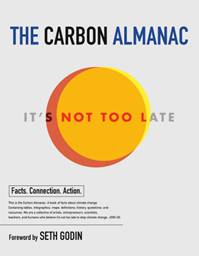Connections for the STEM Classroom
GVSU faculty and area experts provide engaging ideas on current topics in research and education
Carbon at the Center of the Climate Crisis
A book review of "The Carbon Almanac: It’s Not Too Late"
By Kaylynne Dennis 1, Kyle McKee 2, Connor Gabel 3, and Bopi Biddanda 1
1 Annis Water Resources Institute, Grand Valley State University, Muskegon, MI 49441
2 Department of Statistics, Grand Valley State Uiversity, Allendale, MI 49401
3 Grand Haven High School, Grand Haven, MI 49417
“There’s one issue that will define the contours of this century more dramatically than any other, and that is the urgent and growing threat of a changing climate”
– Barack Obama (UN Climate Summit, 2014).
Carbon is vital to life and plays a critical role in regulating the intensity and distribution of global heat – thereby shaping weather and climate. Since the industrial revolution, humanity has drastically changed the balance of the global carbon cycle. More and more greenhouse gas CO2 emissions are being pumped into the atmosphere than are being withdrawn from it – resulting in global warming. In The Carbon Almanac: It’s Not Too Late, over 300 volunteers passionate about the climate crisis come together to illustrate the narrative of today's carbon cycle on Earth. Forewarded and edited by Seth Godin, this ~331-page anthology is not simply a collection of essays from various individuals, but rather integrates mediums such as charts, graphs, reports, cartoons, and poems relevant to the unfolding climate crisis.

The Carbon Almanac: It’s Not Too Late by Seth Godin, 2022 https://thecarbonalmanac.org/ (Portfolio/Penguin, pp. 331, ~$20).
The Carbon Almanac is organized into sections that take readers through the historic relationship between carbon and humanity. Beginning with climate change for rookies and eventually proposing the possible and likely scenarios of the future, this book is valuable to all levels of learners. There is hardly a subject relevant to climate change that is not discussed. This visually engaging book is the result of collaboration between writers, researchers, and thinkers to map out carbon’s impact on our food system, ocean acidity, agriculture, energy, biodiversity, extreme weather events, the economy, human health, and paint the best and worst-case future scenarios.
While still being informative and realistic, the point is made that there is some time (though it may be limited) left for action to be taken and enable our planet to recover. The pandemic-induced lockdown is referenced in this hopefulness, as our planet started to heal during the weeks of the initial shutdown when CO2 emissions temporarily tanked. While the climate crisis is stark and even anxiety-inducing, hopelessness and complacency will get us nowhere in the fight to reduce emissions. The Carbon Almanac is effective in its messaging. This anthology makes it clear that worldwide systemic change is needed. However, it does not ignore the differences we can make as individuals and the climate conscious decisions we can make every day.
Additionally, there is a useful 65-page resource booklet to bring to the classroom – Educator’s Guide: Empowering Learners to Change the World - a companion to The Carbon Almanac. The network of volunteers who contributed to The Carbon Almanac also have a series of podcasts – The Carbon Almanac Collective, where they discuss the production of The Carbon Almanac, Generation Carbon, aimed at teaching children about the climate crisis and getting them involved, Carbon Sessions, and The Carbon Connection.
In summary, The Carbon Almanac is a timely and useful reference regarding the central role carbon plays in ongoing global warming and why resolving the carbon problem is critical to solving the impending global climate crisis. Our planet is in trouble, it is time everyone got informed about the growing imbalance of the carbon budget and collectively act to decarbonize. Reading and making use of the resources within The Carbon Almanac is a good way to begin Earth’s restoration. More importantly, it is an excellent classroom resource on the carbon cycle for both students and teachers as well as the broader public. The book has something that can be utilized by Earth/Climate/Health Sciences, Industry, Agriculture, Trade, Pharmaceuticals, Economics, Sociology and Politics where our everyday choices matter. Our take: Read and share this book with others.
“A democracy that doesn’t include the voice of the environment will fail. We need the environment for coexistence”
– Oladesu Adenike (Young Change-Maker, UNICEF, 2019).

